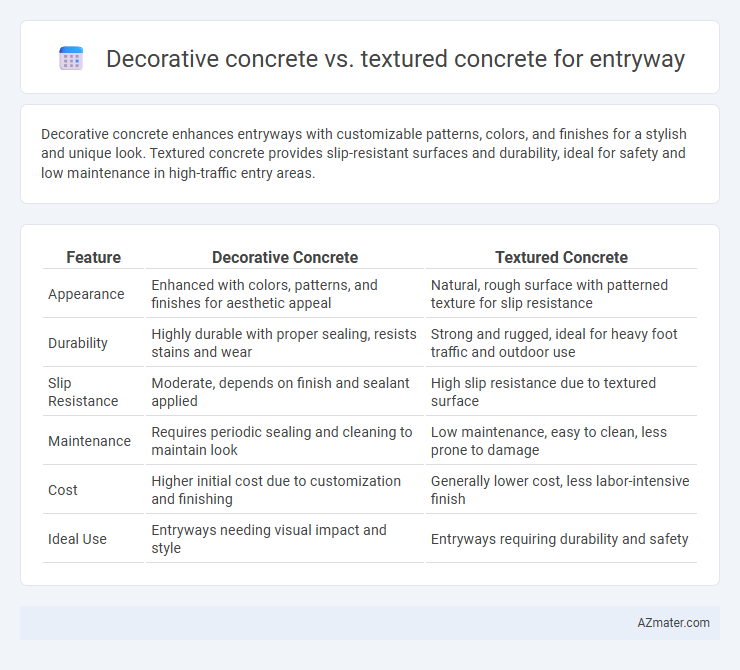Decorative concrete enhances entryways with customizable patterns, colors, and finishes for a stylish and unique look. Textured concrete provides slip-resistant surfaces and durability, ideal for safety and low maintenance in high-traffic entry areas.
Table of Comparison
| Feature | Decorative Concrete | Textured Concrete |
|---|---|---|
| Appearance | Enhanced with colors, patterns, and finishes for aesthetic appeal | Natural, rough surface with patterned texture for slip resistance |
| Durability | Highly durable with proper sealing, resists stains and wear | Strong and rugged, ideal for heavy foot traffic and outdoor use |
| Slip Resistance | Moderate, depends on finish and sealant applied | High slip resistance due to textured surface |
| Maintenance | Requires periodic sealing and cleaning to maintain look | Low maintenance, easy to clean, less prone to damage |
| Cost | Higher initial cost due to customization and finishing | Generally lower cost, less labor-intensive finish |
| Ideal Use | Entryways needing visual impact and style | Entryways requiring durability and safety |
Introduction to Concrete Entryway Options
Decorative concrete offers customizable patterns, colors, and finishes that enhance the visual appeal of entryways, making them unique and inviting. Textured concrete provides slip-resistant surfaces with raised or embossed designs, ideal for safety and durability in high-traffic areas. Both options combine functionality and aesthetics, allowing homeowners to tailor entryways to their style and practical needs.
What is Decorative Concrete?
Decorative concrete enhances entryways by incorporating pigmentation, stamping, and staining techniques to create visually appealing surfaces that mimic natural materials like stone or brick. It offers customizable patterns and colors tailored to complement architectural designs, increasing curb appeal and property value. Compared to textured concrete, which focuses primarily on slip resistance and surface roughness, decorative concrete emphasizes aesthetic versatility and artistic expression.
What is Textured Concrete?
Textured concrete for entryways features a surface pattern created by stamping, brushing, or imprinting while the concrete is still wet, enhancing slip resistance and visual appeal. It offers a durable, non-slip finish ideal for outdoor entrance areas prone to moisture and foot traffic. Decorative concrete, while also customizable, emphasizes aesthetic options such as color, stains, and overlays, but textured concrete specifically prioritizes functional surface texture combined with design.
Aesthetic Appeal: Decorative vs Textured Concrete
Decorative concrete for entryways offers a versatile range of design options including stamped patterns, colored overlays, and polished finishes that create vibrant and customized visual appeal. Textured concrete, on the other hand, emphasizes surface variations like broom finishes or exposed aggregate to provide a natural, slip-resistant look that enhances tactile interest without bold color changes. Choosing between decorative and textured concrete depends on the desired balance between artistic expression and functional durability in entryway aesthetics.
Durability and Longevity Comparison
Decorative concrete offers enhanced durability with protective sealants that resist staining and wear, making it ideal for high-traffic entryways. Textured concrete provides excellent slip resistance and can effectively conceal surface imperfections, contributing to its longevity in outdoor settings. Both options ensure long-lasting performance, but decorative concrete typically requires more maintenance to preserve its aesthetic appeal over time.
Slip Resistance and Safety Considerations
Decorative concrete and textured concrete both enhance entryway aesthetics, but textured concrete offers superior slip resistance due to its rough surface profile, reducing accident risks in wet or icy conditions. Slip resistance ratings such as the coefficient of friction (COF) are typically higher in textured finishes, contributing to safer pedestrian access. Selecting textured concrete for entryways prioritizes safety without compromising visual appeal, making it ideal for high-traffic residential or commercial areas.
Maintenance Requirements
Decorative concrete for entryways typically requires regular sealing to protect against stains and wear, enhancing its durability and appearance over time. Textured concrete, while naturally slip-resistant and robust, demands periodic power washing and occasional resealing to maintain its grip and prevent dirt accumulation. Both options benefit from routine cleaning but differ in maintenance intensity, with decorative concrete needing more frequent attention to preserve intricate finishes.
Cost Comparison: Decorative vs Textured Entryway Concrete
Decorative concrete for entryways typically costs between $8 and $18 per square foot, depending on the complexity of patterns, colors, and finishes, while textured concrete averages around $6 to $12 per square foot due to simpler stamping or broom finishes. Decorative concrete often requires higher installation and maintenance expenses due to custom designs and sealants, whereas textured concrete offers a budget-friendly alternative with moderate durability and less frequent upkeep. Choosing between decorative and textured concrete depends largely on budget constraints and desired aesthetic impact for the entryway.
Customization and Design Flexibility
Decorative concrete offers extensive customization options with a wide range of colors, patterns, and finishes that can be tailored to match any entryway design. Textured concrete provides design flexibility through various embossing techniques that create unique surface textures resembling natural materials such as stone or wood. Both options enhance curb appeal, but decorative concrete allows for more intricate and personalized aesthetic choices in entryway applications.
Choosing the Best Concrete Solution for Your Entryway
Decorative concrete offers customizable colors and patterns ideal for enhancing entryway aesthetics, while textured concrete provides superior slip resistance and durability for high-traffic areas. Selecting the best concrete solution depends on balancing visual appeal with functional requirements such as safety and maintenance. For an entryway, prioritize decorative concrete if design and curb appeal are paramount; opt for textured concrete when durability and slip resistance are critical factors.

Infographic: Decorative concrete vs Textured concrete for Entryway
 azmater.com
azmater.com